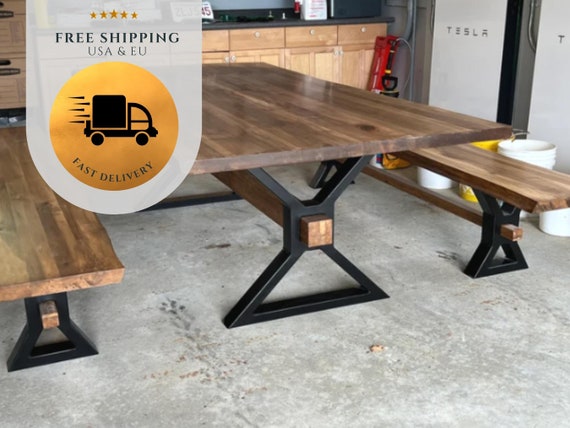Distinct Dining Room Table Legs to Change Your Eating Area
Wiki Article
A Detailed Check Out Table Leg Styles: Discovering the Ideal Suit
Picking the best eating table leg style is crucial for both aesthetic appeal and practical capability. Typical 4 legs provide timeless style and security, while the pedestal base provides boosted legroom and a contemporary look. For those with bigger tables, trestle legs guarantee durable assistance, whereas barrette legs introduce a mid-century modern ambiance with their minimalist design. The x-shaped legs mix contemporary design with improved stability. Each of these choices brings unique benefits, making the selection greater than just an issue of preference. Check out additionally to find which style completely complements your eating room and way of life.Conventional Four Legs
Among the various types of dining table leg designs, the typical four-leg design remains a timeless choice for many households. Four legs offer balanced support, ensuring the table continues to be secure and qualified of birthing considerable weight (dining room table legs).From an aesthetic perspective, the traditional four-leg layout can be conveniently adjusted to numerous interior designs. Whether crafted from timber, metal, or a combination of products, these legs can be intricately sculpted, streamlined and minimalistic, or anything in between. Their adaptability enables them to complement both rustic and modern setups perfectly.
Additionally, the straightforward framework of the four-leg style helps with ease of activity and positioning within a space. Unlike even more complex bases, this design lessens obstructions, giving sufficient legroom for restaurants. In recap, the conventional four-leg table leg design marries sustaining sophistication with useful functionality, making it an astute selection for those seeking both form and feature in their eating furnishings.
Pedestal Base
Often commemorated for its elegant and space-efficient design, the stand base is a prominent choice to the conventional four-leg arrangement in table leg designs. This distinctive base typically features a solitary central column sustaining the table top, which can vary in form, from ornately sculpted wood to smooth, modern metal. Among the primary advantages of the pedestal base is its capability to make the most of legroom and seating adaptability. Without edge legs, diners are paid for better flexibility of activity, making it a perfect selection for round and oblong tables that promote more intimate and comprehensive celebrations.Additionally, the stand base's main assistance can deal with considerable weight, enabling using much heavier table tops, such as marble or thick wood. This strength coupled with its aesthetic flexibility makes the pedestal base a prominent option in both standard and modern indoor setups. It can seamlessly integrate with different design themes, from classic style to minimalist modernity. Additionally, the central column itself provides a canvas for elaborate styles and artistic expressions, including an hop over to these guys aspect of aesthetic rate of interest below the table. In summary, the pedestal base incorporates capability with design, making it an improved and useful option for diverse eating atmospheres.
Trestle Legs
Trestle legs supply a durable and ageless foundation for eating tables, identified by their straight cross-bracing and durable assistance beam of lights. Stemming from medieval times, this layout has progressed yet preserved its essential framework, making it a seasonal fave in both conventional and modern settings. The central trestle light beam, typically supported by 2 or more upright posts, uses remarkable stability, enabling larger table sizes without the demand for extra legs.A substantial advantage of trestle leg tables is the enough legroom they offer. Unlike tables with 4 edge legs, the absence of blockages at the table's sides provides unobstructed room for chairs and diners, boosting convenience and ease of access. This makes trestle tables excellent for accommodating bigger celebrations, whether in a dining-room or a reception hall.
The aesthetic flexibility of trestle legs is notable. Readily available in a variety of products such as timber, metal, and composite, they reference can be completed to match a wide variety of interior designs. From rustic farmhouse to smooth modern-day designs, trestle legs can be personalized to fit individual preferences. Their long-lasting appeal and practical benefits make trestle legs an engaging option for those looking for both design and practicality in their table.
Barrette Legs

The allure of barrette legs depends on their simplicity and adaptability - dining room table legs. Available in a variety of products, including steel and brass, they can be completed in countless colors to match various indoor styles. Whether paired with a rustic wood table top or a modern glass surface, hairpin legs easily mix functionality with a touch of classic beauty
Sturdiness is an additional remarkable feature of hairpin legs. Regardless of their fragile look, these legs are crafted to bear substantial weight, making sure the eating table continues to be stable and protected. In addition, they are reasonably very easy to install, making them a popular choice for DIY lovers and specialist furnishings manufacturers alike.
X-Shaped Legs

Constructed from materials such as steel, wood, or a mix of both, X-shaped legs can be customized to match various layout preferences. Steel legs commonly offer a sleek and industrial feel, suitable for loft-style apartment or condos and modern-day dining areas.
In addition, the design behind X-shaped legs straight from the source ensures even weight distribution, reducing the danger of wobbling and boosting longevity. This makes them particularly well-suited for larger table that require additional support. Basically, X-shaped legs blend functional design with contemporary appearances, making them a classic selection for varied dining environments.
Conclusion
An extensive understanding of dining table leg styles reveals the distinct characteristics and advantages of each layout. Typical 4 legs use stability and timeless appeal, while pedestal bases offer legroom and a streamlined appearance. Trestle legs ensure durable support for larger tables, and hairpin legs present a mid-century contemporary aesthetic. X-shaped legs integrate modern style with improved stability. Choosing the proper leg design makes sure both practical and aesthetic satisfaction in any kind of eating area.Report this wiki page